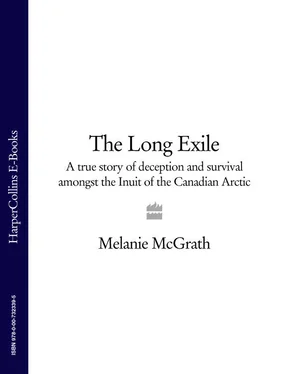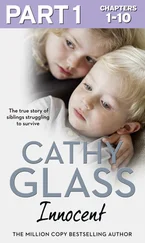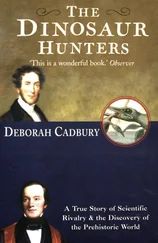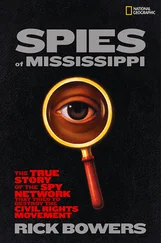As for Josephie, he just watched.
Pat Reid's remarkable fight came to be seen as the last good thing to happen in Ungava for a very long time and it marked the end of Josephie's untroubled early life. Later that year, the price of fox fur plummeted. A creamy, unblemished pelt which, the preceding winter, would have sold for C$7 or C$8 fetched only C$1.50, not much more than whalers would have paid for it a quarter-century before. To add to the problem, the Hudson Bay Company acquired a controlling stake in Révillon Fréres and had taken out the competition. As prices slipped further, trappers were soon forced to go out to their trap lines every day, extending them beyond their usual confines into unfamiliar terrain. But foxes were scarce that year and no rise in the numbers could in any case make up for the fall in the price of a pelt. The Inuit held on, expecting things to change. Within weeks, they had eaten all their credit at the store and by 1930 the situation was becoming desperate, as the principal markets for Arctic fur sank further into the slump. For the first time in a decade, the hunger the Inukjuamiut had so happily forgotten roamed around the camps once more.
Though Josephie was unable to comprehend the vagaries of the Montreal fur market or, on a larger scale, the fragilities of economic cycles and stock markets, he was as well able to feel his empty stomach as anyone. In Arctic conditions, a human being requires three times the number of calories that he might in temperate zones. From time to time and for short periods during Josephie's early life the Nujarluktuk family had gone hungry, but this new hunger had certain novel qualities. First, it seemed unrelated to any physical conditions. The weather had not changed, the fox cycle was unaltered. The abstract nature of this famine made it peculiarly frightening. Added to that was the fact that the concentration on trapping had left many families more dependent on store-bought food. Had the starvation hit a decade before, many families would have had dried meat and fish and meat cheese cached away, but they had grown used to buying flour and sugar, and their meat and fish caches had dwindled. Lastly, no one travelled as far and as often as they once had done, so the camps were closer together and the population less widely scattered. Each family's hunting grounds now overlapped more widely with those of its neighbours. Hunting and trapping trips began to take on a relentless, desperate quality.
About that time, so the story goes, Maggie Nujarluktuk's husband's sled was found out on the sea ice and, beside it, a neat, man-shaped hole. Of the truth of this, there is still no knowing. Of the man himself, there remains no trace. An accident would have made sense but whether it was an accident or not, the timing of the death of Maggie's husband could not have been worse. For a while Maggie and Josephie got by on soup boiled from the stomach contents of seals and walrus given them by their relatives, but with no hunter in the family, it was not long before they were forced to move in with the dead husband's brother, Paddy Aqiatusuk. From then on, they were Paddy's charges, their survival in his hands.
Luckily for Maggie and her children, Aqiatusuk was no ordinary Inuk. People went to Paddy when they had family disputes, or decisions to make. They went to him with their sick children or their hungry dogs. They sought his advice on camp politics, on alliance-making and settling scores. If they had a disagreement with the fur post manager they would ask Paddy to act as advocate. He was the nearest thing the Inukjuamiut had to a marriage broker, psychologist, politician, sage and benign patriarch.
Paddy Aqiatusuk was also an artist. In his spare time he took pieces of green soapstone and walrus ivory and carved. And what carvings! Bears, walrus, hunters, seals, that would make you forget everything except their cool, seductive contours and graceful lines. In time, Paddy's carvings would grace museum collections across North America and Europe.
And so it is easy to imagine Josephie, shy, self-effacing and at an awkward, in-between sort of age, advancing towards his new stepfather with trepidation and a kind of puppyish awe, and his mother, amused and a little embarrassed by her son's zeal, scolding the boy, with something like, ‘Don't tail after the man, you'll bother him.’
But Josephie Flaherty did not bother Paddy Aqiatusuk. Between the growing boy and the sculptor a firm friendship began. No Inuk boy could have wanted a better teacher, no Inuk man a keener student. True, Aqiatusuk was demanding and often grumpy (too little ihuma , undoubtedly), but it was through being in his salty, bear-like presence that Josephie began to leave behind his childish sense of the world and find his way as a hunter and a man. All through the early 1930s, Josephie and Aqiatusuk were companions on the land. During the soft summers, they paddled their kayaks across the swell of Hudson Bay while the sculptor pointed out the unexpected currents, odd tides and anomalies of beach and shore and the boy noted the bays and inlets, taking in the contours of the coast. For days they paddled along the Hopewell Islands, out west to Farmer Island as far as Kogaluc Bay in the north, to the Nastapokas, the Marcopeet Islands and the Sleepers in the south. From these expeditions, Josephie learned to predict the tides, the effect of the winds and the rain and the sun on the sea. He became familiar with the ice and the currents. He discovered where to look for bearded, harp and ringed seal, walrus and beluga whale.
His education continued through the hard winters. From Aqiatusuk he learned how to harness dogs and ice the runners of the komatik and to pack a sled so that it did not topple when the going was rough. Together they drove out across the land-fast ice, through pressure ridges, to the pack ice beyond. They ranged way beyond the low hills, where Josephie and Maggie had stopped to pick willow, to the huge, empty spaces of the interior. Aqiatusuk showed Josephie how to lead the dogs, reading their mood, sensing when it was best to run alongside, when more prudent to ride on the komatik with the whip, when to discipline the team and when to give them their freedom, when to offer them meat and when to let them go hungry. Gradually, young Josephie distinguished the different and subtle ways in which dogs use their intelligence. By his mid-teens the son of Robert Flaherty was an expert in dogcraft.
Those trips were Josephie's introduction to the tumultuous churn of ice. Slowly, he learned how to recognise the thin sheet ice which formed from freezing rain and could cover the lichen and starve the caribou. He learned how to spot the thick layer of frozen melted snow which could conceal deadly melt holes below. He sensed when the sikuaq or ice soup, which began to form in the sea at the end of August, had become thick enough to bear weight and, later in the year, he recognised when the ice was likely to candle, throwing up the sharp spines that sliced sled dog paws. He learned to watch for ice rising up at the hinges between the ice foot and the shore-fast ice and to predict where it would rear up to form the turbulent, slabby ice ranges the Inuit called tuniq . He observed the shadows on the sea left by black ice, and those accompanied by frost smoke which marked open water. He discovered where treacherous ice skins were most likely to be lying across leads and where tiny tremors and a blanching of the air signalled there was land ahead.
Under Aqiatusuk's guidance, he acquainted himself with the habits of Arctic animals, where each preferred to live and how and what it ate, where it travelled, how it paired and bred, for how long the young remained close to their mothers, where they were at their most vulnerable. He learned how to stalk caribou on the flat, wind-blown tundra, and how to use a white fur baffle to outfox seal. He came to a precise understanding of where and when to fling the harpoon or release the bullet that would make a creature his. He discovered the arts of flensing and butchering meat and where to store it so that wolves, foxes and dogs could not take it. When Aqiatusuk had fox pelts to trade, he took his stepson with him. The boy learned how to talk to white men and how much not to say.
Читать дальше












